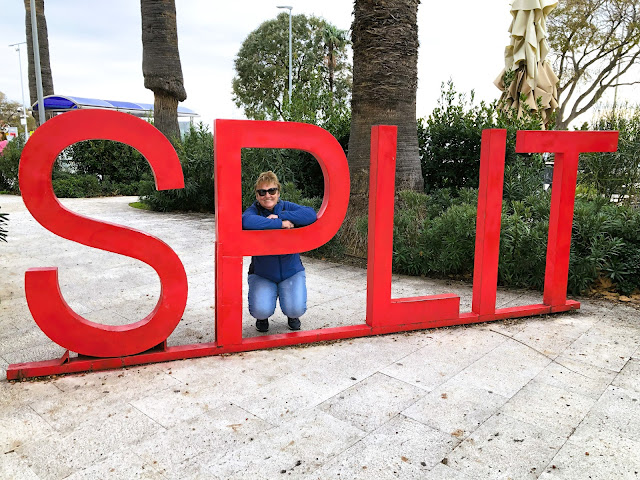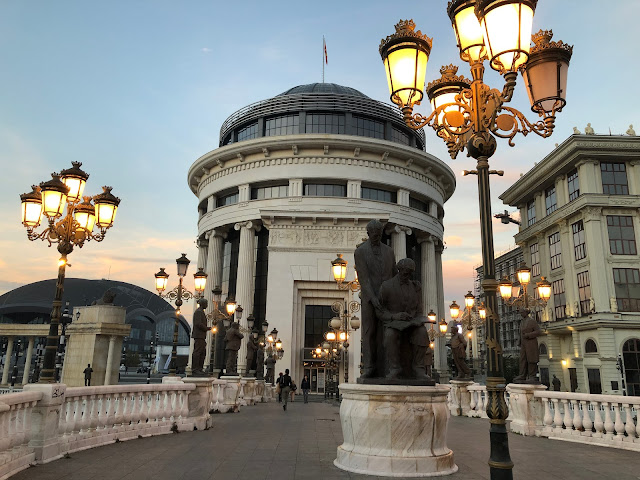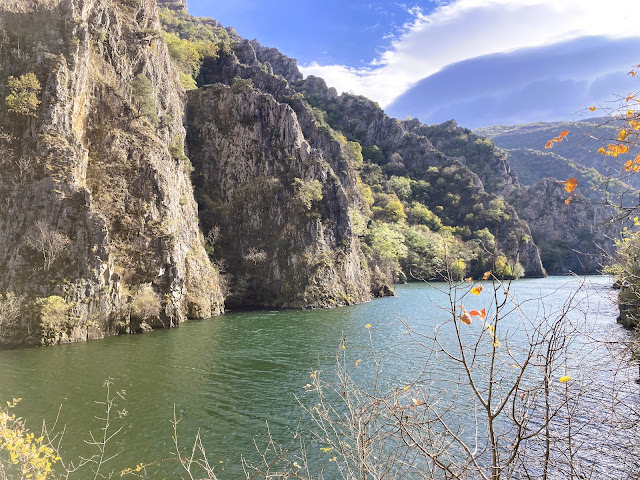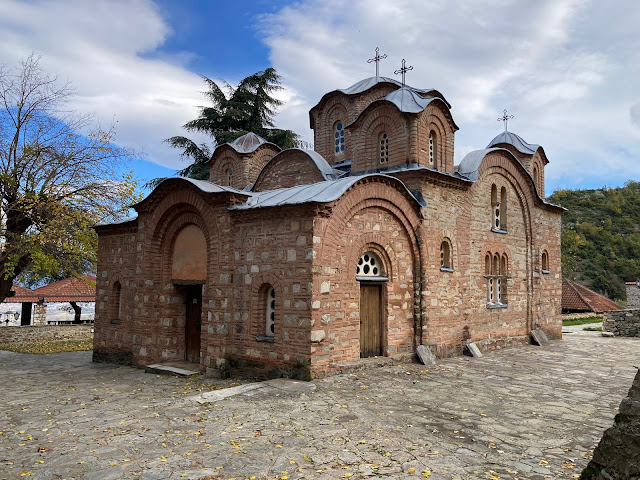EUROPE –
PART 7
In terms of
area and population, Montenegro is the smallest country we’ll visit on this
trip. It’s about twice the size of Prince Edward Island and has a population of
600,000, a little more than Newfoundland and Labrador and a little less than
New Brunswick. Montenegro is considered to have an upper-middle-class economy
and ranks quite high on the UN’s Human Development Index, a measure of life
expectancy, education, and per capita income. Among the eight countries we’ve
visited in this part of Europe, only Slovenia and Croatia rank higher. Montenegro
is a member of most of the important international “clubs”, uses the Euro as
its currency, and appears well on its way to becoming accepted as a member of
the European Union.
Canada
ranked first on the Human Development Index through most of the 1990s but has
been falling steadily since. Remember Jean Chrétien’s 1996 declaration: “People throughout the world wonder why a province like Québec
is not happy to live in the best country of the world!” The
Scandinavian countries, Australia, and New Zealand rank higher than we do while
the US and the UK are both below us and heading in the wrong direction.
Kotor is a
small city of some 13,500 residents and its location at the head of the Bay of
Kotor makes it an ideal port of call for cruise ships. We spent a day in Kotor
on our very first cruise in the fall of 2013 and will visit two other ports of
call from that trip, Dubrovnik and Split. The old town is a UNESCO World
Heritage Site, protected because of its restored and well preserved medieval
landscape and the walls that surround its hilltop fortress. Our hotel, the
Monte Cristo, is the best we’ve stayed in so far in terms of value for money
and it certainly deserves its four-star rating.
There was a chill in the air when we left our hotel after breakfast, but the sun soon warmed our bones as we strolled along the bayside promenade. Kotor is the perfect place to explore on foot as there are so many beautiful things to see: the narrow streets, the Bay of Kotor, and the hilltop fortress that soars above the old town’s many churches. A picture = 1,000 words!
Dubrovnik’s
main attraction is its fortified old town, one of the most impressive you’ll
see in Europe and a UNESCO World Heritage Site. We arrived after a leisurely
three-hour bus ride from Kotor. It was a cold day but, since the forecast for
the next day was looking pretty wet, we walked to the old town right after
checking into our hotel. Our ship called into Dubrovnik on our fall 2013
cruise and the feature that had struck me as we came through the gate was the
shiny marble streets. As you can see from the photo below, they’re as shiny as
ever. I can’t imagine why they wouldn’t be. I was here only ten years ago while
walkers’ feet have been polishing them for probably five centuries now.
We wandered through the narrow alleyways and made our way to the marina. There are several museums in the old town but none that interested us as much as the fresh air and a healthy walk. It’s nice to come back to a place you enjoyed and be able to see it properly a second time. After dinner, we had a nice chat with a group of high school students from Rouyn-Noranda, Québec, who were on a ten-day class trip. They were fun to talk to, engaging and enthusiastic.
Alas, the
weather gods were against us on our second day in Dubrovnik as we awoke to a
driving rainstorm and a strong wind blowing off the Adriatic. We know we’re
pushing the envelope travelling at this time of year, but the occasional bad
weather day isn’t enough to dampen our spirits. I walked Elva to the shopping
mall and that was enough to put a smile on her face!
We had one morning left in Dubrovnik and it dawned bright and sunny. After breakfast, we walked to the old town again and took in the sights and sounds of major preparations for the Christmas season. Crews were installing trees and garlands everywhere and others were setting up kiosks along the main street. We found a quiet spot by the water just outside the massive walls and listened to the water lap against the rocks, sitting there like two old cats warming our bones.
Then, it was
off again, this time to Split. We picked up our vehicle, a Citroen C4X,
probably the nicest car I’ve ever rented. It’s an eight-speed automatic, AWD, fully
loaded, rides like a dream, and it goes like stink. If I could fit it in my
suitcase, I’d take it home with me! We thoroughly enjoyed the three-hour ride, the
first part along the shore of the Adriatic, featuring scenery that rivals the
Cabot Trail and the Gaspé Peninsula.
Split, home
to 160,000, is Croatia’s second-largest city. It first became famous in the
year 305 when Diocletian, the Roman Emperor, built a palace here. Like Kotor
and Dubrovnik, Split has preserved its old town, a UNESCO World Heritage Site. We
visited here for a day in 2013 and wanted to take the time needed to see the
place again.
Diocletian was
a mean SOB who hated Christians. It’s ironic that, a mere twelve years after
his death in the year 312, Christianity became the Roman Empire’s preferred
religion under Emperor Constantine. Even more ironic is the fact that the main
part of Split’s Catholic cathedral, St. Domnius, is Diocletian’s repurposed
mausoleum! St. Domnius, completed around the year 600, is the oldest Catholic
cathedral still in regular use. Its strange-looking exterior makes it probably
the ugliest church I’ve seen, but its unique history makes it a must-see.
And, of
course, we had to climb to the top of the bell tower to get a better view of
the city. While there, I offered to take a photo of a group of four people. “Where
are you from,” I asked one of the men. “Canada, Saskatchewan, actually,” he replied. “I’m from
Charlottetown,” I said. “My grandfather was an Aitken from Lower Montague,” he
told me! God, it’s a small world!
Of the three cities we’ve visited on the Adriatic, Split is our favourite. Its old town is significantly larger than Kotor’s and is more of a self-contained community than Dubrovnik’s. Here, you can see locals exchanging pleasantries in the fish market, shopping at the supermarket, and generally going about their business without ever having to leave. Split and Ohrid are the two places we’ll come back to if ever we visit this part of the world again.
We made the best of our second full day in Split by taking the advice of a guide we'd met in the Old Town. He'd suggested we take a day trip and visit Salona, Trogir, and Sibenik, so we did. Salona is nothing more than a collection of ruins, Christian on top of Roman, typical of this part of the world, just across the crick from Italy, as it were. We found it boring. Trogir, on the other hand, is a charming medieval town built on a tiny island connected to the mainland by a bridge. It’s a UNESCO World Heritage Site.
Sibenik, further up the coast, has an interesting old town as well, and contains the impressive St. James Cathedral, built in the early 1400s of limestone blocks quarried nearby. A student of architecture would understand the building’s significance and what qualified it for UNESCO designation. What impresses me is how devoted people in Europe are to preserving their built religious heritage, whatever the cost.
And we couldn’t
resist one more after-dinner stroll through Old Town Split. It’s the last time
we’ll see 20 C for a while.
On our way
back to Zagreb, we stopped at Plitvice Lakes National Park. The parking lot was
almost empty, as you’d expect on December 2. It started to pour just as we were
getting out of the car, so we put on our Helly Hansens, opened the umbrellas,
and walked to the edge of the canyon, directly across from the big falls. We walked
down the path until we got to the bottom, crossed on the boardwalk, and made
our way to the base of the falls. Just before we got there, we heard a distant
rumble of thunder and thought we should turn back.
But the majesty of the place got the better of us and we just kept going until, finally, the rain slowed to a drizzle. The wooden path takes you across falls and up cascades that separate each small lake from the one above. It’s an experience unlike anything we’d ever done. We walked for an hour or so until we reached one of the larger lakes, waited there for a boat to take us across to a dock, and rode a shuttle back to near where we’d started on the path. Everything about Plitvice is world class: the setting, the signage, the trails, the boat, the shuttle; just everything!
- Northern Europe is bordering on too expensive for us. As a matter of fact, the cheapest way to see those countries is from a cruise ship. The eight countries we visited further south are much more affordable and every bit as rich experience-wise.
- The seven countries that make up the former Yugoslavia have a combined area about the size of our three Maritime provinces and a population of some 20 million. Only one city, Belgrade, has significantly more residents than Halifax. The other capital cities (we didn’t visit Podgorica, capital of Montenegro) are relatively small, even by Canadian standards, and are in the process of forming their respective identities after barely thirty years as the seats of federal governments.
- The countries we visited in Southeast Europe have a bad reputation, mostly due to the 1990s Balkan Wars, Communist régimes, and the fallout therefrom. The federal government’s Travel Smart website says to exercise “A high degree of caution” when visiting Bosnia-Hercegovina, but nothing about Kosovo and Serbia where tensions are greatest between religious and ethnic groups. We felt none of that anywhere we went.
- Abandoned and half-finished buildings dot the landscape in this part of Europe, particularly in Albania and those areas affected by the Balkan Wars. Imagining how difficult the transition from a situation where the Communist government owns and controls everything to one where individuals can once again own property and run a business makes my head hurt. How do you decide who gets what under a free market economy? How do you resolve disputes when the courts are not yet functioning and there’s no property title system? One of our guides told us that when disputes over property can’t be resolved, the parties involved simply walk away leaving empty building shells behind.
- The lifestyle of people in Slovenia and the northern part of Croatia is more “European” than in the more southern areas we visited. This is no doubt due to their stronger economies. The people are also not as friendly and outgoing as those in the south.
- YouTube is a valuable research tool when planning a trip like this. I came across many written travel guides on the web, and we used these on the YouTube search engine to broaden our knowledge. Some of the videos are amateurish, but we eventually found what we were looking for.
- We’ve
learned that staying a minimum of three nights in one city is the best formula
for exploring a country or a region whether we have a vehicle or not. It gives
us time to get to know the place and find interesting day trips.
- We
don’t always have a set plan for every day. We find it’s best to be open-minded
about seeing where the path or the road will take us. Sometimes we have a list
but, if we don’t see everything on our list or get sidetracked by something
more interesting, that’s OK too.
- I don’t mind driving a rental but like to mix in bus travel on a trip like this one. A rental gives you more flexibility and makes it easier to plan day trips but mixing it up with aggressive and impatient city drivers can be tiring. And just try buying PL and PD insurance for a rented car; impossible to find with any car rental company and VISA’s car rental insurance doesn’t cover it.
- You can travel in this part of Europe for less than $350 per day at this time of year, considerably less than the cost of a cruise. Four-star hotels average $160 per night, with breakfast, and we picked some excellent ones through booking.com. Restaurant meals can be had for under $50 for a three-course dinner (except for Slovenia and Croatia) and most attractions are reasonably priced as well. The only places we needed local currency were toilets and taxis!
- Being
friendly always helps! Learning a few simple words like “please” and “thank
you” will always get you a smile since the locals can spot a tourist from a
mile away.
- It’s easy to get old. It’s staying young that’s hard. As my mother used to say: “There’s no fool like an old fool!”

















































